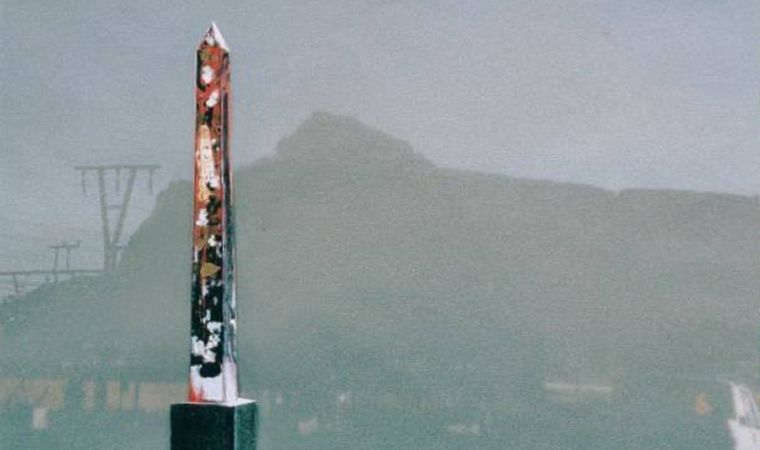|
THE RAINBOW-OBELISK FOR SOUTH AFRICA - A PRESENT FROM THE FEDERAL REPUBLIC OF GERMANY AND THE LAND BERLIN ASSOCIATION WITH GERMAN INDUSTRY.
The Artist, Hella Santarossa about her Project:
The Rainbow-Obelisk will be a bi-cultural exchange between South Africa and the Federal Republic of Germany, with the help of the State of Berlin and German industry.
Is South Africa the right place for the Rainbow-Obelisk?
In the eyes of the world, South Africa, the southernmost point of the continent, symbolizes an area of hope for peaceful co-existence within a multicultural population.
The country has forged its own cultural identity, and, with its first participation at Biennale in 1995, has opened itself to cultural exchanges within the international scene.
As a Berlin artist, I especially try to present a critical reflection of the spirit of the age in and through my work. For this reason, I want to observe and accompany the latest developments in South Africa's culture.
Hands are stretching out in the hope of international co-operation. I want to clasp these hands and work together with South African artists to realize the Rainbow-Obelisk. The Obelisk, as a symbol for victory; the victory of human dignity over apartheid should grow like a monument for the journey towards the hopeful future of the infant democracy. For this reason I see myself as the leader in the background of this idea of working together. We all should learn from the traditional African culture on the way to the future. The geometric form and the design of colors represent the state of South-Africa especially the area between Johannesburg and Pretoria, as an area of the new way in a multi-cultural generation. The yellow parts of the Obelisk stand for the richness of the resources; white is the color of the transparency of glass. The local area will be represented by the color green to suggest the stones in the neighborhood. This is also the place for the calligraphy of the South African artists. The sky will create the blue color in the Obelisk.
This would give shape to the spontaneous ideas I had while driving down between Pretoria and Johannesburg. Suddenly I had a luminous glass installation in mind, which seemed to represent both - the present and the future of south Africa.
The Curator, Dr. Martina Weinland
The continent of Africa - the cradle of mankind - will play a determining role in the 21st century. Hella Santarossa's ideas, in particular, the land of South Africa as the seat of aesthetic challenge and progress.
The German artist, Hella Santarossa, has lived and worked in Berlin since 1980 and to this, her city of choice, she has left many 'Landmarks of Art'.
Her surely most well known installation, which has meanwhile taken on emblematic significance, is the 15 m high 'Blue Obelisk' which was erected in Berlin in 1995.
The glass sculpture displays fragments of text on each individual segment, which reach beyond its regional location to represent the history of Europe and other continents. This means for Hella Santarossa: "Culture is the soul of mankind." And thus, the choice of Africa as continent for her second Obelisk installation project was certainly not without ethnological considerations.
In contrast to the 'Blue Obelisk' of Europe, which consciously breaks down the traditional monolithic form into individual compartments, the Rainbow Obelisk in Africa will retain its etymological form.
The palette envisioned for the glass will reflect the colors for the national flag of South Africa. It will include references to the wealth of minerals resources of the country, such as gold, diamonds and coal.
The "Rainbow-Obelisk" is projected to stand 30 meters high on a pedestal of green granite; the stone will come from the Indian Ocean. The calligraphy on the lateral surfaces should be designed and processed by South African artists.
The realization of this multi-ethnically binding project should be prepared beforehand in workshops of the Art Academy or the Goethe-Institute in South Africa together with local artists. This involves the design stage as well as the technical and financial implementation. With a project on such a scale, this will mean - as with the large-scale projects of Christo and Jean-Claude - an enhancement of experience for all those taking part.
Work stage:
Design meeting with colleagues on site, parallel to this, public relation activities, realization strategies and financial acquisition, then structural realization with art work both on glass and stone.
© hella santarossa |


